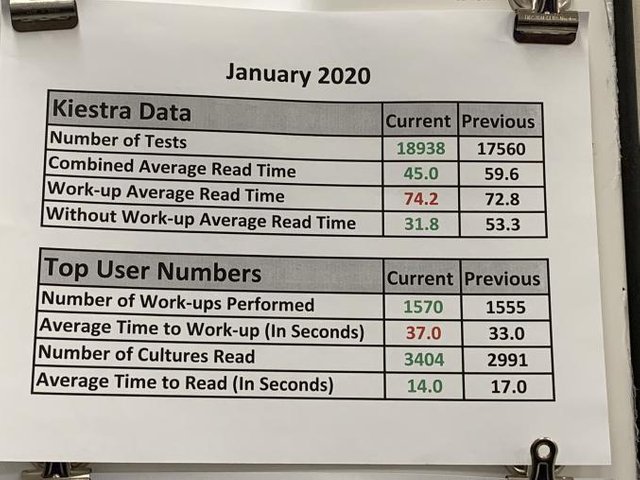Ever wonder how much workload a clinical lab at a good-sized hospital process in a month? Well, here's a partial look at those statistics. The numbers here only apply to tests and patient samples that ran through the BD Kiestra. In short, it is an automatic line for microbiology.
The Kiestra itself would be a lengthy write-up in itself as it is a complex assembly line.

Keep in mind, the above stats do not include things done offline. The not included numbers consist of blood, fungal, acid fast, anaerobes cultures, and so on. Most of the rapid tests, such as wet prep or rapid antigen tests are also not in this figure. They can be also be cultures from other hospitals sent to our facility.
Explaining the Stats
Read Time (No Work-up)
This is where the lab update culture status (i.e. no growth, finalizing) and ordering work-ups. In short, it goes like this:
Is the culture complete?
If yes, proceed to finalize the report.
If no, does it need more work-ups?
If yes, then order the necessary work-ups. If not, hold culture until it is time to finalize. The reason for holding is to see if any other pathogen could be there. Some microbes grow slower than others.
Work-up Read Time
A work-up is anything that helps the lab to "complete" the culture. This can be identification, susceptibility testing, etc.
On average, it takes a technologist 74 seconds to prepare for the pieces of the puzzle are still missing. Someone is fast enough to do it in 37, but it doesn't tell us the breakdown of those work-ups. Some work-ups, such as Strep typing, only take a few seconds to confirm. While others, such as identification via MALDI-TOF, takes a bit more consideration.
We do not keep track of how long it takes to perform those tasks as they vary from batch to batch. On average, using the MALDI-TOF takes the longest time due to the length of operation. Strep typing and subbing out cultures take the least amount of time.
Comments
A 14-second read time may seem fast, but it may have more to do with updating no growth or finalizing cultures.
Given that I work 7 on 7 off, if I were to pull the top numbers, I would do a lot of work each night. For example, it would mean I read 243 cultures and 112 work-ups per 10-hour shift.
Of course, that is not the case because I spend a lot of time doing other things such as blood, AFB, and fungal cultures.
In the End
What the table doesn't show is turnaround time for cultures. The turnaround time is the actual time the culture goes from start to finish. It starts when the department checks the sample into microbiology. It ends when the lab finalizes the culture.
The coordinators and supervisor review the reports as they become finalized. To some degree, it is a layer of check before clinicians interpret the results we gave them.
That's a quick glimpse of what happens at a large laboratory. So, when people message me while I'm at work, know that I'm transient. If I don't respond right away, I'm most likely in the middle of something.
Congratulations @enforcer48! You have completed the following achievement on the Steem blockchain and have been rewarded with new badge(s) :
You can view your badges on your Steem Board and compare to others on the Steem Ranking
If you no longer want to receive notifications, reply to this comment with the word
STOPTo support your work, I also upvoted your post!
Vote for @Steemitboard as a witness to get one more award and increased upvotes!
Downvoting a post can decrease pending rewards and make it less visible. Common reasons:
Submit